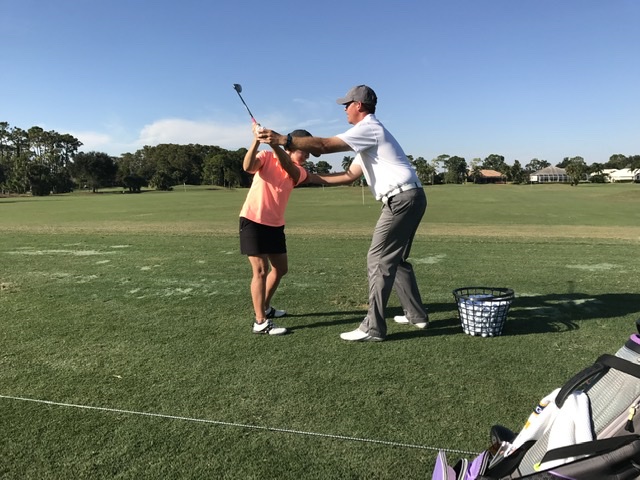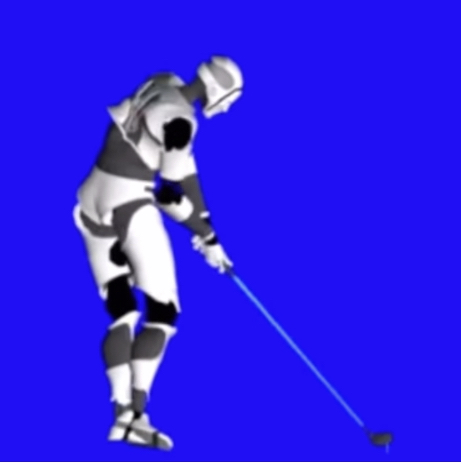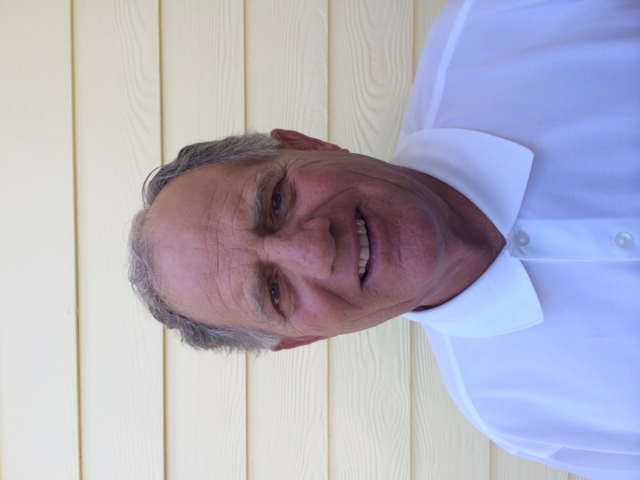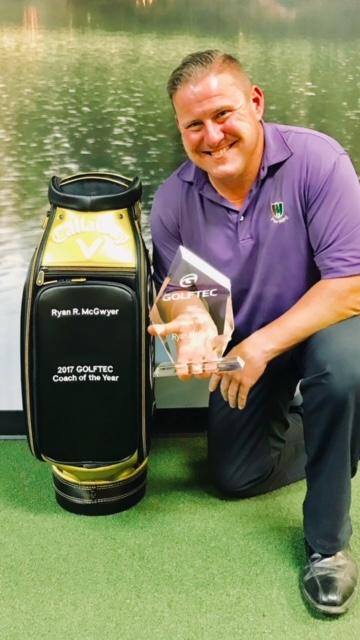Spend less on golf balls and lower your score: Top ways to fix your slice
It's Path or Face... or Both!
A golf ball will slice because the club face is open to it’s path at the moment of impact, now which is the bigger issue for you? Is it an Open Club Face or is it the “Out-to-In” Club Path? Many times they work off each other, if you swing across your body you might hold the face open through impact resulting in a slice ball flight, for others, they have an open face at the top of their swing and they try to swing in the opposite direction in which they normally hit the ball leading to an exaggerated curve. Watch the video below to see what influences an open face, and an out-to-in path. When you are ready to make the change, don’t be afraid to feel uncomfortable, whether it is grip, alignment, or swing shape, it will have to feel very different in order to make a lasting change.
Correcting a slice
Slices can have multiple root causes, but the answer is simple: The face points to the right of the path (for a right hand golfer) at impact.
Causes can be:
1: A grip that is too weak causing the face to point to the right.
2: An outside in swing path
3: Poor hand/wrist action which open the face through impact
Corrections are to make sure the grip is aligned correctly. Learn to swing on the correct path (This is tricky and involves posture that tilts away from the target, hips leading the swing, not arms). Keeping the right hand on top (or rotating over) through impact.
Really want to improve your golf game? Get incredible swing tips delivered to your inbox every week.
The Clubface Sends It; The Swingpath Bends It!
Components of Solid Ball Striking
Thomas T. Wartelle, PGA & WGTF Professional
Facebook @ Instagram : @TTWGOLF
The short answer: There is only one cause of a slice. The clubface position at impact is open to the path of the club at impact. The differential between the face and path determines the amount of curvature (spin axis) on the ball flight. This is assuming that the shot was hit on (or very near) the sweat spot.
Great ball strikers all have something in common: they consistently achieve five factors at impact in relation to the intended target line. I abbreviate “intended target line” as ITL. The ITL is the benchmark target the golfer is trying reach starting at impact.
The five human performance factors at impact are: 1) club face position to the ITL, 2) club path to the ITL, 3) centeredness of contact, 4) angle of approach, and 5) club head speed. All great ball strikers achieve a high level of each of these components. However, two really stand out, club face position and centeredness of contact. If one does not strike the ball with the center of gravity or sweet spot of the golf club, there can be other influences on the ball flight.
One such factor that can influence the ball flight is the gear effect. The gear effect has influence on the spin axis. To understand this, you must understand some basic principles. Golf shots have backspin, not side spin. To be simple, imagine a golf ball in the air with wings on each side. When the “wings” are horizontal, the ball flight will not curve. If the “wings” tilt down left, the ball flight will curve left. If the “wings” tilt down right, the ball flight will curve right. Again remember, golf shots have backspin rotating on a center axis. The ball flight curvature is just a tilted axis. Therefore, a golf shot stuck on the sweet spot is influenced by the face and path at impact.
A simple phrase I use: club face sends it; swing path bends it. The combination of the face and path at impact determine the ball flight; however, when the ball is struck off center, the gear effect also becomes a factor. A ball struck towards the heal of the club or the toe of the club imparts more influence on the spin axis. For a right handed golfer, a heal strike has more right biased spin axis and a toe strike has more left biased spin axis. This becomes more influential with clubs like the driver and fairway woods because the center of gravity is further back. The gear effect is more pronounced on these types of clubs.
The last two human performance factors at impact are angle of approach (or attack) and club head speed. The angle of approach can dramatically affect the club path and club face position. A simple thing as a change in the angle of attack can impact dynamics for better or for worse. This gets into a discussion of the D-Plane which I will leave for another article. Lastly, the club head speed at impact has obvious influence on the ball flight. However, notice I put it intentionally last. Speed is important but is the least important of this group.
As teachers, remember this tip. The easiest impact factors to change are club face position, centeredness of contact, and angle of attack. A person’s ability to increase speed may be limited and their overall swing direction is probably already ingrained. However, a simple change in ball position could completely change a person’s club face position, centeredness of contact, and angle of approach at impact. Changing the angle of approach can change the club path at impact to the ITL. All of this without ever changing the golfer’s overall swing direction. Remember at impact- The club face sends it; the swing path bends it!
© 2018 Thomas T Wartelle & TTW Golf
Facebook @ Instagram : @TTWGOLF
Stabilize the Face
The typical high handicap or novice golfer will roll their club face open on the backswing. Their club face moves very low and inside on the backswing. By low and inside, I mean the club is behind them early and too flat as compared to their shoulder plane at address. This under the plane backswing will lead to a very steep downswing.
The club face is stabilized when the right handed player properly moves the left hand during the backswing.
An excellent drill for mastering club face stabilization is called the “Rockettes Drill” from Martin Chuck, PGA.
Learn how to properly assume the positions of this drill and even hit shots using this drill. Once you have mastered the drill you will better understand the fundamentals of the golf swing.
Fix Your Slice
Slicing the golf ball is one of the most common shot shape of amateur golfers. The most common issues golfers make are setup (aim, grip, stance, & posture), sequencing (topdown vs bottom up), and loss of lag through the down swing. In the linked video I discuss 5 ways to fix your slice and give helpful drills to correct your swing patterns. Check out more of my videos through my channel or by visiting www.kingprogolf.com.
Fix That Slice!
Are you slicing the ball? Are you frustrated? Let’s fix it! The most common error that amateur golfers make, which leads to a slice, is poor alignment! When your feet are aimed one way and your shoulders are aimed another way, you’re in trouble! I find that with most right-handed golfers who SLICE, poor alignment comes from your feet aiming to the right and your shoulders aiming to the left. During a lesson, I stand behind my students and hold an alignment rod across their shoulders. Then, I ask them to look at the target so that they can see how far to the left the alignment rod is pointing. This means the golfers shoulders are “open.” Open is to the left of the target. The result is a golf swing path that swings to the left, every time! Characteristically known as “over the top.“ Fix this problem easily!!! Here’s how: Get two alignment rods. Lay one of them on the ground, a foot from your golf ball and pointing at the target. Hold the second alignment ride across your shoulders and take your address position over the ball. Make sure that the alignment rod that you are holding across your shoulders is parallel to the one that you placed on the ground. Are you square to the target, with both your feet and your shoulders? If not, then wiggle around a bit at address, until you can get your shoulders pointing at the target and parallel to alignment rod on the ground. You’re ready now! You will fix that “path left, over the top move” that is causing you to SLICE!
Enjoy! (Visit your local PGA Golf Professional from more help)!
Turn your shoulders and complete your backswing
In my opinion, many times when I see golfers hitting a slice, they never fully turn their shoulders or get their left shoulder behind the ball. I try to have students feel like their left shoulder is completely under their chin and behind their golf ball at the top of their backswing.
Know your clubface and path
Where is your clubface at impact? What is the path of the club? If your clubface is open to your path (path to the left, clubface aiming to the right for example), this is a main cause of slicing.
Drill: Slow down the swing (75% slower), and learn/feel to match the clubface with the path. The next time you practice, work on getting the path more to the right. Again, keep the swing very slow to feel the change.
Face or Path??
The simple physics (for right handed player) in putting slice spin on ball is that the face angle at impact is to the right relative to the club path. I will usually examine those two variables and the swing to establish if either is a strength and change technique to correct the other as much as possible. In general, I like to get the face squared or closed at impact first and I like to use ‘obstacles’ on ground like tees, impact bag, or water bottles to correct path. Learn to hit some solid draws/hooks and then bring it back to straight!
Slicer Fixer Upper
Most common causes of a slice is pulling in towards your left hip as your come through the ball. This causes side the face to move/rotate open on impact. Creating a side spin as it comes off of the clubface. The placement of your eyes is a major factor as well. Looking at the side of the ball, can cause you to pull towards the target, thus causing the over the top motion, creating the side spin.
One drill I like to tech my students not to pull over the top is to take the club up full to your backswing, then drop the club behind you. Finish your full swing forward while the club drops. This teaches your muscles to drop down instead of push outwards. Allowing your to swing full through without any pull in your shot. Repeat this till you can feel the drop in your swing before your turn starts.
Another way to think of it, is to picture a low outside fastball that yo want to hit to right center field. Swing with a slight outwards path to help keep that face closed through the ball. If you are coming over the top, there is no way to bring that club anywhere but towards your body. Hug your right elbow closer to your side, and allow yourself to swing on an outward path.
“Fix Your Grip”
Most golfers who slice have a weak grip with the left hand. Just keep moving your left hand over to a stronger position til the slice becomes a pull and you’ll be on your way to a better game !!!!
Slices start with a bad grip.
If you were going to take 1 golf lesson and get your money’s worth as a new golfer it would be wise to spend it on the grip. The grip is the only thing connecting you to the club and has a huge impact on your ability to square the face. Too many golfers grip the club in front of them and get the left had too “weak” (crease formed by thumb and index finger too far toward left shoulder. )
The more your hands go to the right on the club (stronger grip) the more the ball will go left. If every new golfer had to take mandatory (drivers ed) and learned to grip it correctly we would have a large percentage of golfers playing in the 70s in a short amount of time. Thank god there is no drivers ed or I may be out of a job, and I love what I do for a living!
Starts with a turn
The most common slice I see is the classic “over the top” where the club cuts across the target line. The face angle is open to that path; otherwise you’d see a pull. Although this path is often caused by “throwing” your hands from the top (casting), I believe the root of the problem starts in the takeaway.
If a golfer picks up their hands in order to reach the top of the backswing, they tend to find themselves in a position where the hands are high and the only place to go is out and down. This causes an across the target line path that is disaster. Instead, try this: turn your left shoulder over your right knee (left-handed golfers turn your right shoulder over your left knee).
Starting the club back with a shoulder turn puts the club on the proper swing path/plane which in essence turns the club around your body. The swing path is an arc around your spine – turning your shoulders turns the club around you. I have found that getting the club in a good position at the top makes golfers less likely to cut across the target line. Instead, the club comes back to the ball on the proper path (from the inside), allowing for a better chance to square the club.
All that’s left is to release the clubhead through the ball, squaring it at impact. Let this happen, don’t force it…but that’s a completely different lesson. Good Golfing!
Slicers & their swing path
The first thing to know about slicing is if you slice-it is because the face of your club is open to the swing path. The most common swing path with slicers is when they swing outside to in, meaning for a right handed golfer- their club is swing too far to the left as they pass through the ball. Their balls start to the left and then slice to the right. If either their path or face angle are only moderately off this can be a very playable shot. Pull fade. The worse situation is when the player has an inside to out swing path, meaning the club swings too far to the right through the ball for a right handed player, and the face is open. This is referred to as a push slice, pretty much unplayable. The common denominator with both of these situations is an open club face. Often this a result of extending or cupping the left wrist on the back swing or unhinging to soon on the down swing and not being able to rotate the hands through the ball.
To help with closing the hands hit little shots trying to get the club to point in one of 3 ways, too far right, too far left and straight. After a little practice you will be better able to square the club with your full swings.
Pre-swing Fundamentals should be the main focus!
Golfers must understand that the swing that produces a slice is the result of poor fundamentals before the club starts in motion. The grip controls the club face and is usually one of the root causes of a slice, so gripping the club properly is paramount. From there alignment and ball position take center stage.
Slicers usually align to the left of the target with the ball positioned to far forward. Use alignment sticks to help get set-up correctly and make sure the shoulder alignment matches the feet. The ball should be inside the left heal for right handed golfers using a driver and more centerish when the ball is on the ground. The outside in path the club takes to produce a slice is usually deeply engrained so a golfer must start with half swings to help them eliminate the outside in path. Half swings with half speed all the while focusing on a more inside approach to the ball. If contact is improving go to three quarters then full swings.
Seek out your PGA Professional to better understand what you need to work on to eliminate the slice and play better golf.
Faulty connection to the handle
A slice is all due to a faulty connection to the handle. What I mean is putting hands on the Handel in a position that causes the clubface to be open at impact. The number one drill that came out of a test on lots of people on how to cure a slice , came from the people being tested. They said of all the things you teachers said to do, turning the toe of the club inward at address was the best cure and quickest cure.
A “strong grip” with both hands placed on the right side of the Handel, exaggerated, then moderated if needed is best for the long term “swing for life!”
Chip Beck drill
I believe that the most common cause of the slice is the body outracing the arms on the downswing, thus forcing the arms out and over the target line. In order for the ball not to go straight left, the club face is kept open, which causes the ball to curve drastically from left to right for a right handed golfer.
I remember seeing Chip Beck practice this drill back in the day because he was curving the ball too much from left to right. He would draw his right foot back behind his left foot and hit balls. I tried this and it works. The right foot back slows down the hips and body and allows the arms to catch up and pass the body at impact. Try it some time if you are slicing the ball, you might be amazed!
Close the toe of clubhead
You need to see the second knuckle on your left hand at address shoulders on insides of feet left foot open about 45 degrees turn chest hips going back then push off the ground right foot right knee and start closing the toe of clubhead coming down and hit all the way thru with left hand. Then you don’t have to pay for lunch somebody is going to buy you lunch.
PGA Tour Superstore - East Palo Alto, East Palo Alto, CA
Setup and Swing Path
Slices come from putting a spin on the ball from left to right (right handed golfer). The spin on the ball is caused by the path of the club through impact. Slice spin comes from an outside to in swing path. Many techniques are taught on how to fix a slice. Start with your setup.
The most common mistake starts in the setup. If your feet and shoulders are open to the target (left of target for right handed golfers) your swing will likely follow. Make sure your feet and shoulders are in line with the target or even closed to the target.
Then try standing just slightly farther away from the ball and think about hitting the inside (closest to your body) half of the ball.
Lastly, try placing a towel between your right elbow and right rib area (right handed golfers). When you swing, make sure the towel doesn’t fall to the ground. This will help keep your right arm close to your body and stop you from casting the club away from your body and hitting the ball with left to right spin.
Fix the grip, fix the slice
The root cause for the majority of slicers that I see is a weak positioned grip. It leads to in-swing issues that are simply the body’s way of trying to correct the open face caused by the poor grip. The best way to correct it is to see your local pro and have him show you the proper Vardon grip. It won’t feel comfortable for awhile, but it will start working immediately.
For those who slice and have sound grips, it’s most likely a too far inside path, leading to an over the top downswing. This imparts slice spin on the ball and a too steep downswing. Your local pro can help with this as well.
Most Common Cause Of A Slice
The most common cause of a slice is an out-to-in club path with an open face at impact. The drill that I like to have students use to work in this is a drill involving the use of an alignment stick and a swim noodle. Take the alignment stick and push it into the ground on the same angle as the club’s shaft angle when addressed that you are hitting. Place the swim noodle over the top of the alignment stick to prevent any chance of injury if the player still swings out-to-in while doing the drill. Place the ball directly behind the alignment stick and have the player try to hit the ball without hitting the stick. This drill will help promote a more in-to-out path.

















